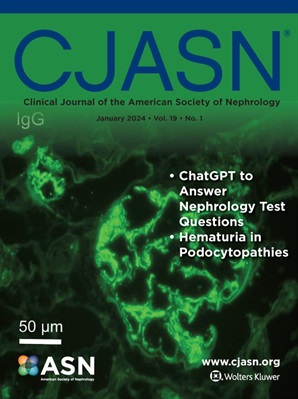Phenotypes of Dialysis-Requiring Acute Kidney Injury and Associations with Mortality in a South American Population.
IF 8.5
1区 医学
Q1 UROLOGY & NEPHROLOGY
Clinical Journal of the American Society of Nephrology
Pub Date : 2024-09-12
DOI:10.2215/cjn.0000000000000530
引用次数: 0
Abstract
BACKGROUND Acute kidney injury (AKI) is a complex syndrome typically classified into strict categories. Alternatively, it may be more accurate to consider it as an intermediate event between an initiating cause and its outcome. Therefore, we investigated the burden of clinical scenarios associated with dialysis-requiring AKI (AKI-D) using latent class analysis (LCA) and examined the etiological spectrum and clinical phenotypes across different life stages. METHODS We analyzed 17,158 AKI-D patients from 170 medical facilities in Rio de Janeiro, Brazil (2002-2012). Utilizing survival curves and mixed-effects Cox regression for survival estimation, LCA classified patients based on clinical characteristics and outcomes, focusing on etiological variation over the human lifespan. RESULTS The median age was 75 (IQR 59-83). Infections were the most common cause (44.2%), particularly community-acquired pneumonia (23.8%). Cardiovascular issues, especially ischemic heart disease (9.0%) and acute heart failure (8.1%), were also significant. LCA identified four distinct patient classes with varying clinical and outcome profiles. Class 1 patients were younger (median age 66), predominantly male, with lower ICU admission and higher rates of community-acquired AKI (60.8%). They had the lowest mortality (39.5%) and highest recovery rates. Class 2 had intermediate mortality (67.4%) and the highest comorbidity burden (mean Charlson score: 3.39). Classes 3 and 4 had the highest mortality (82.8% and 78.6%), requiring more mechanical ventilation and vasopressor use. Class 3 had a high prevalence of sepsis (92.7%) with lower comorbidities, while Class 4 had high chronic heart disease (76.3%) and perfusion factors (79.4%). Despite high mortality, Class 3 recovered better than Class 2 and 4. Survival analyses revealed diverse outcomes across etiological groups, with liver-related conditions being the most severe. CONCLUSIONS This study highlights the complexity of AKI and the utility of LCA in revealing its clinical heterogeneity. It underscores distinct etiological trends across ages, suggesting future research should integrate clinical profiles with advanced diagnostics to understand AKI's clinical and molecular phenotypes throughout life.南美人口中需要透析的急性肾损伤表型及其与死亡率的关系。
背景急性肾损伤(AKI)是一种复杂的综合征,通常被严格分类。或者,将其视为起因和结果之间的中间事件可能更为准确。因此,我们使用潜类分析法(LCA)调查了与透析要求的 AKI(AKI-D)相关的临床情景的负担,并研究了不同生命阶段的病因谱和临床表型。结果中位年龄为 75 岁(IQR 59-83)。感染是最常见的病因(44.2%),尤其是社区获得性肺炎(23.8%)。心血管问题也很重要,尤其是缺血性心脏病(9.0%)和急性心力衰竭(8.1%)。LCA 确定了四类不同的病人,他们的临床和治疗结果各不相同。1 类患者更年轻(中位年龄为 66 岁),以男性为主,入住重症监护病房的比例较低,社区获得性 AKI 的比例较高(60.8%)。他们的死亡率最低(39.5%),康复率最高。2 级患者的死亡率居中(67.4%),合并症负担最重(平均 Charlson 评分:3.39)。3 级和 4 级的死亡率最高(分别为 82.8% 和 78.6%),需要更多的机械通气和血管加压。3 级患者脓毒症发病率高(92.7%),合并症较少,而 4 级患者慢性心脏病(76.3%)和灌注因素(79.4%)较多。尽管死亡率较高,但3级患者的恢复情况优于2级和4级。本研究强调了 AKI 的复杂性以及 LCA 在揭示其临床异质性方面的作用。结论:本研究强调了 AKI 的复杂性以及 LCA 在揭示其临床异质性方面的作用,并强调了不同年龄段的不同病因趋势,这表明未来的研究应将临床特征与先进的诊断技术相结合,以了解 AKI 在整个生命周期中的临床和分子表型。
本文章由计算机程序翻译,如有差异,请以英文原文为准。
求助全文
约1分钟内获得全文
求助全文
来源期刊
CiteScore
12.20
自引率
3.10%
发文量
514
审稿时长
3-6 weeks
期刊介绍:
The Clinical Journal of the American Society of Nephrology strives to establish itself as the foremost authority in communicating and influencing advances in clinical nephrology by (1) swiftly and effectively disseminating pivotal developments in clinical and translational research in nephrology, encompassing innovations in research methods and care delivery; (2) providing context for these advances in relation to future research directions and patient care; and (3) becoming a key voice on issues with potential implications for the clinical practice of nephrology, particularly within the United States. Original manuscript topics cover a range of areas, including Acid/Base and Electrolyte Disorders, Acute Kidney Injury and ICU Nephrology, Chronic Kidney Disease, Clinical Nephrology, Cystic Kidney Disease, Diabetes and the Kidney, Genetics, Geriatric and Palliative Nephrology, Glomerular and Tubulointerstitial Diseases, Hypertension, Maintenance Dialysis, Mineral Metabolism, Nephrolithiasis, and Transplantation.

 求助内容:
求助内容: 应助结果提醒方式:
应助结果提醒方式:


